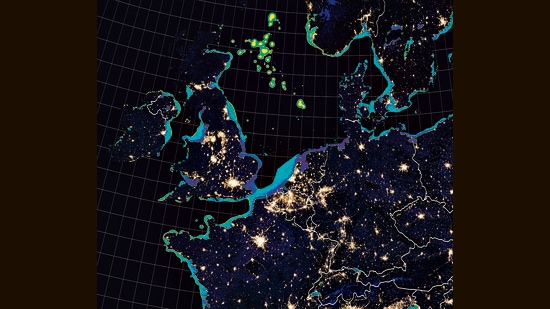A new sea monster: See how light pollution is disturbing the ocean depths
Coastal megacities and LED lights emerge as the biggest disruptors in a new world atlas of oceanic light pollution. See which regions are worst-affected.
City lights are disturbing the darkness as much as 40 metres below the surface of the seas, a new world atlas of oceanic light pollution has found.

The atlas maps just how much light from Artificial Light at Night or ALAN sources is entering the seas. It turns out that the most heavily impacted marine regions include the Persian Gulf, the western coast of Saudi Arabia and portions of the South China Sea, with ALAN penetrating up to 40 metres in these regions, all the way to a distance, typically, of 10 to 20 km from the coast.
“The impact is exacerbated in regions with particularly clear water such as the Mediterranean Sea, Red Sea and the Persian Gulf. Offshore oil and gas platforms contribute to this sub-surface pollution,” says Tim Smyth, an oceanographer at the Plymouth Marine Laboratory and lead author of the study.
The atlas took two years to build, with eight researchers from the UK and Israel collaborating. Findings were published in the journal Elementa.
Though all kinds of light, from skyscrapers to street lighting to port lighting, contribute to light pollution in water, it is the unshaded light that goes upwards and is back-scattered by clouds or gas molecules in the atmosphere that has the most impact, the study found. “That is also how you see a city from a great distance,” Smyth says.
Another factor contributing to the rise in this kind of pollution is the growing use of light-emitting diode or LED lights. “In the UK, in the last five to 10 years, there has been a move towards LED lights which are more energy-efficient but peak more in the blue end of the spectrum, unlike the lights they are replacing which are more yellow or orange. Light that peaks in the blue zone penetrates water to greater depths, particularly clear waters. In the UK, this kind of light is being increasingly used for streetlights,” Smyth says.
A 2016 world atlas of artificial night sky brightness created by Fabio Falchi, physicist and researcher at Italy’s Light Pollution Science and Technology Institute, formed the basis of this study. It gave the researchers a ready data set on the world’s most light-polluted zones.
The other key data points came from a global ocean colour dataset produced by the European Space Agency’s Climate Change Initiative. Ocean colour depends on how light interacts with materials in the water and hence can indicate how much light is being absorbed. These data sets, combined with overnight field study and an in-water light penetration model, were used to create the atlas.
The hope is that the atlas can now be used by marine researchers to assess the impact of artificial light on marine species and ecosystems.
Catch your daily dose of Fashion, Health, Festivals, Travel, Relationship, Recipe and all the other Latest Lifestyle News on Hindustan Times Website and APPs.
Continue reading with HT Premium Subscription




